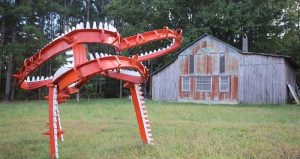






Seven Locations to Discover Black History in Halifax County
Throughout February, we reflect and celebrate the contributions of African Americans to our nation and communities. Rich in history, Halifax County is a perfect place to commemorate the contributions made by people of African descent. The locations listed below are ideal for celebrating the triumphs, observing the struggles, and recognizing the contributions of local African Americans to our county (and the world) over the past two centuries.
Mizpah Presbyterian Church
Mizpah Presbyterian Church sits on land that was once the Mizpah School. Constructed in 1901, the school taught reading, writing, arithmetic, and bible hymns and versus to black students. Further cementing its importance to the community, it was converted to a community daycare center in 1935, one of the first of its kind in Southern Virginia.
Mary Bethune
Mary Bethune has a long history in education. In 1827, the site was home to a private training center for African Americans. In the 1920s, the school was rebuilt, later being upgraded and renamed Mary Bethune School. By 1950, it was the largest rural high school for black students. It is reported almost half of the graduates went to college, well above the national average at the time. The current building was erected in 1956 as the county tried to meet “separate but equal” laws and prevent the integration of local schools. The school found itself at the center of the local integration movement, finally serving as a desegregated junior high in 1970.
Washington Coleman Community Center
Washington Coleman Community Center’s origins date back to 1875. Seeking to educate black youth, Reverend Ragland started a private school in his backyard. He was later able to secure financial support from the Town of South Boston, the first known public support of black education in the county. The one-room school grew, eventually becoming the Coleman Grammar School, which operated until 1948 when it merged with Washington High. After the county was integrated, the building was renamed Washington Coleman Elementary, and the building now serves as a community center.
Meadville Community Center
The story of Meadville Community Center begins with Caleb Robinson, who sought to create a place where African Americans could gather, enhancing and educating the community. In 1893 he formed the McKinley Institute on land he purchased from the county. He brought in teachers from the north to teach African American girls. He donated the land on his deathbed, expressing his desire for a community center. Through community efforts of African American Baptist Organizations and local leaders, the community center opened in 1978.
L.E. Coleman African American Museum
Recently added to the Civil Rights in Education Trail, the L.E. Coleman African American Museum was originally a school. Built in 1919, the school taught black students in the community. In 2005, the building was remodeled and opened to the public as a museum. The museum’s mission is “to research, collect, and preserve the art, history, and culture of African Americans with emphasis on Halifax County and to foster among people the awareness and perspective from the past and find purpose for the future.”
Note: The first five locations are stops on the African American Heritage Trail in Halifax County. These locations are also on the Civil Rights in Education Trail, alongside multiple sites across central Virginia. To learn more about the Civil Rights in Education Trail and other stops across the region, click here.
Diamond Hill at Berry Hill
For a more somber reflection of history, Berry Hill still has reminders of its past as a plantation. There are several well-preserved slave quarters on the property, which visitors can view and imagine living conditions from centuries ago. Diamond Hill, the largest slave burial ground in Virginia, is located at the rear of the property near the Dan River. The cemetery has around 200 uninscribed headstones carved from locally available stones. Diamond Hill can be accessed via the Tobacco Heritage Trail or the hiking trails at Berry Hill. Please note that the cemetery is not routinely maintained; trails and the site itself may be overgrown.
The Resting Place of Henrietta Lacks
As a young girl, Henrietta Lacks moved in with her grandfather in a log cabin near Lacks Town Road in Clover. She spent her childhood in Halifax County, working in tobacco fields alongside her family. After marriage, she and her husband moved to Maryland. Following the birth of her last child, she was tested for complications which lead to the discovery she had cancer. During her treatment, samples of healthy and cancerous tissue were collected. The cancerous cells eventually became known as the HeLa Cells, an immortal line of cells that continue to be used in medical research to this day. Sadly, Lacks died of cancer and is thought to be buried next to her mother in a family graveyard off of Lacks Town Road. Though the graveyard is on private property, a historical marker can be viewed on the road.
Interested in learning more about black history in Halifax County?
A Tribute to Black History in Halifax County by Barbara Bass has profiles of several prominent locals who helped shape the community. The book also contains the history of nearby locations and local organizations significant to African Americans.
Black Schools in Halifax County (Late 40’s) by F.A. Burruss documents the condition of black schoolhouses throughout Halifax County as he observed them in the 1940s. Originally a project while working toward a Master’s degree in Education at the University of Virginia, the booklet was printed to preserve historic information.
Black History in Virginia by Barbara Bass includes history from both Halifax and the state of Virginia for those seeking more information about black leaders, movements, and history statewide.



